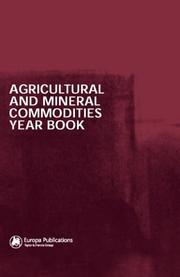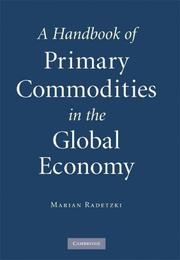| Listing 1 - 6 of 6 |
Sort by
|
Book
ISBN: 1108240410 1108240712 1108240771 110757028X 1316416941 1108240836 1108240895 1108241131 110712980X 1108241077 9781108241137 9781316416945 9781107570283 9781107129801 Year: 2017 Publisher: Cambridge : Cambridge University Press,
Abstract | Keywords | Export | Availability | Bookmark
 Loading...
Loading...Choose an application
- Reference Manager
- EndNote
- RefWorks (Direct export to RefWorks)
The 2010s have been a dramatic period for most primary commodity markets. Producers suffered heavily as prices fell in response to new supply facilities going into production, juxtaposed against disappointing demand evolution from China in particular, marking the end of the most powerful and enduring commodity boom since the Second World War. This book is a guide to the primary commodity universe, an increasingly crucial part of the world economy. In this updated edition, Marian Radetzki and Linda Wårell introduce and explain pertinent issues surrounding international commodity markets, including the importance of fossil markets among commodities, price formation, price trends, the shift in primary commodity consumption towards Asia, the increasing reliance on commodity exchanges, new relaxed attitude towards depletion, cartel action, and the revival of nationalism and state ownership. This is an accessible read for graduates, academic researchers, and professionals in the mineral and energy sectors.
Primary commodities. --- Primary commodities --- Commercial policy. --- Foreign trade policy --- International trade --- International trade policy --- Trade policy --- Economic policy --- International economic relations --- Basic commodities --- Commodities, Basic --- Commodities, Primary --- Primary products --- Commercial products --- Prices. --- Government policy

ISBN: 1857431502 020341232X 9786610064267 1135356114 1280064269 020340355X 9780203403556 Year: 2002 Publisher: London : Europa Publications,
Abstract | Keywords | Export | Availability | Bookmark
 Loading...
Loading...Choose an application
- Reference Manager
- EndNote
- RefWorks (Direct export to RefWorks)
Annotation
Commercial statistics --- Farm produce --- Mineral industries --- Primary commodities --- Produce trade --- Agricultural marketing --- Agricultural products --- Food trade --- Basic commodities --- Commodities, Basic --- Commodities, Primary --- Primary products --- Extractive industries --- Extractive industry --- Metal industries --- Mines and mining --- Mining --- Mining industry --- Mining industry and finance --- Agricultural commodities --- Produce --- Agriculture --- Food industry and trade --- Commodity exchanges --- Commercial products --- Industries --- Food --- Raw materials --- Plant products --- Economic aspects

ISBN: 9780521880206 9780511493584 9780521182645 9780511388194 0511388195 9780511380365 0511380364 9780511383489 0511383487 0511387202 9780511387203 0511493584 0521880203 0521182646 0521880203 1107184215 128125486X 9786611254865 0511386176 0511384343 0511382537 Year: 2008 Publisher: New York ; Cambridge, UK : Cambridge University Press,
Abstract | Keywords | Export | Availability | Bookmark
 Loading...
Loading...Choose an application
- Reference Manager
- EndNote
- RefWorks (Direct export to RefWorks)
The world is going through an exceptional commodity boom triggered by a global demand shock largely caused by the sudden emergence of China and India as sizeable raw material importers. Prices of numerous commodities tripled between 2003 and 2006, resulting in huge windfalls for producers and a financial squeeze on consumers. A Handbook of Primary Commodities in the Global Economy is a guide to the ins and outs of this increasingly crucial part of the world economy. Assuming nothing more from readers than a basic understanding of economics, Marian Radetzki introduces and explains pertinent issues surrounding international commodity markets such as the global geography of raw materials, price formation, price trends, the role of commodity exchanges, the threat of depletion, cartel action, state ownership and the commodity nationalism.
International economic relations --- Commercial policy --- Primary commodities --- 338.720 --- 338.730 --- 380.23 --- AA / International- internationaal --- Basic commodities --- Commodities, Basic --- Commodities, Primary --- Primary products --- Commercial products --- Foreign trade policy --- International trade --- International trade policy --- Trade policy --- Economic policy --- Prices --- Landbouw (algemeenheden) --- Extractieve nijverheid: algemeenheden --- Vorming van internationale prijzen. Internationale gelijkheden en verschillen. Concurrentievermogen --- Government policy --- Primary commodities. --- Commercial policy. --- Prices. --- Business, Economy and Management --- Economics
Book
ISBN: 1475585683 9781475585681 1475585659 Year: 2017 Publisher: Washington, D.C. : International Monetary Fund,
Abstract | Keywords | Export | Availability | Bookmark
 Loading...
Loading...Choose an application
- Reference Manager
- EndNote
- RefWorks (Direct export to RefWorks)
This paper investigates the effect of timeliness in accessing the intermediate inputs on the trade pattern. In particular, any country that has a higher ability to transport goods on time has a comparative advantage in industries that place a higher value on the timely delivery of their inputs, and this comparative advantage pattern is stronger for processed goods than for primary goods. To do this, a measure for how intensively any industry demands for the timely delivery of its intermediate inputs is constructed combining Hummels and Schaur (2013)’s calculations of the time sensitivity of products with the input-output tables.
Primary commodities. --- Basic commodities --- Commodities, Basic --- Commodities, Primary --- Primary products --- Commercial products --- Primary commodities --- E-books --- Exports and Imports --- Infrastructure --- Trade: General --- Trade Policy --- International Trade Organizations --- Empirical Studies of Trade --- Economic Development: Agriculture --- Natural Resources --- Energy --- Environment --- Other Primary Products --- Industrialization --- Manufacturing and Service Industries --- Choice of Technology --- Economic Development: Urban, Rural, Regional, and Transportation Analysis --- Housing --- Industry Studies: Transportation and Utilities: General --- Investment --- Capital --- Intangible Capital --- Capacity --- Neoclassical Models of Trade --- Macroeconomics --- International economics --- Transportation --- Exports --- Comparative advantage --- Trade balance --- National accounts --- International trade --- Saving and investment --- Balance of trade --- Nepal
Periodical
ISSN: 14476762 Year: 1994 Publisher: Canberra : ABARE,
Abstract | Keywords | Export | Availability | Bookmark
 Loading...
Loading...Choose an application
- Reference Manager
- EndNote
- RefWorks (Direct export to RefWorks)
Agriculture --- Primary commodities --- Economic aspects --- Prices --- Economic aspects. --- Prices. --- Australia. --- Agrarian question --- Agribusiness --- Agricultural economics --- Agricultural production economics --- Production economics, Agricultural --- Basic commodities --- Commodities, Basic --- Commodities, Primary --- Primary products --- Farming --- Husbandry --- Ahitereiria --- Aostralia --- Ástralía --- ʻAukekulelia --- Austraalia --- Austraalia Ühendus --- Australian Government --- Australie --- Australien --- Australiese Gemenebes --- Aŭstralii︠a︡ --- Australija --- Austrālijas Savienība --- Australijos Sandrauga --- Aŭstralio --- Australské společenství --- Ausztrál Államszövetség --- Ausztrália --- Avstralii︠a︡ --- Avstraliĭski sŭi︠u︡z --- Avstraliĭskiĭ Soi︠u︡z --- Avstraliĭskii︠a︡t sŭi︠u︡z --- Avstralija --- Awstralia --- Awstralja --- Awstralya --- Aystralia --- Commonwealth of Australia --- Cymanwlad Awstralia --- Državna zaednica Avstralija --- Government of Australia --- Ḳehiliyat Osṭralyah --- Koinopoliteia tēs Aystralias --- Komanwel Australia --- Komonveltot na Avstralija --- Komonwelt sa Awstralya --- Komunaĵo de Aŭstralio --- Komunejo de Aŭstralio --- Kūmunwālth al-Usturālī --- Mancomunidad de Australia --- Mancomunitat d'Austràlia --- Negara Persemakmuran Australia --- New Holland --- Nova Hollandia --- Osṭralyah --- Persemakmuran Australia --- Samveldið Ástralía --- Usṭralyah --- Usturāliyā --- Whakaminenga o Ahitereiria --- Land use, Rural --- Commercial products --- Industrial arts --- Life sciences --- Food supply --- Aŭstralii͡ --- Australské společenstv --- Avstralii͡ --- Avstraliĭski sŭi͡uz --- Avstraliĭskiĭ Soi͡uz --- Avstraliĭskii͡at sŭi͡uz --- Kūmunwālth al-Usturāl --- Usturāliy --- Ōsutoraria --- Australia
Book

ISBN: 9781616351458 1616351454 1463984839 9786613850478 1463952686 1463923821 1283538024 9781463923822 9781283538022 Year: 2012 Publisher: Washington, D.C. : International Monetary Fund,
Abstract | Keywords | Export | Availability | Bookmark
 Loading...
Loading...Choose an application
- Reference Manager
- EndNote
- RefWorks (Direct export to RefWorks)
Countries with an abundance of natural resources, many of which are in sub-Saharan Africa, often show a record of relatively poor economic performance compared with non-resource-rich countries. The chapters in this volume explore the potential challenges to countries with abundant natural resources and ways to manage these challenges so as to reap the benefits of resource wealth while avoiding the pitfalls. The book is divided into five sections, which explore commodity markets and the macroeconomy, economic diversification and the role of finance, fiscal policy, exchange rates and financial stability, and governance. The ideas in this book were first presented at a seminar in November 2010 that was aimed primarily at policymakers in sub-Saharan Africa and brought together ministers, central bank governors, other senior policymakers, and well-known academics.
Diversification in industry --- Economic development --- Finance --- Fiscal policy --- Foreign exchange rates --- Monetary policy --- Natural resources --- Primary commodities --- Resource curse --- Sovereign wealth funds --- politique industrielle --- richesses naturelles --- Funds, Sovereign wealth --- SWFs (Sovereign wealth funds) --- Investment of public funds --- Curse, Resource --- Natural resources curse --- Paradox of plenty --- Basic commodities --- Commodities, Basic --- Commodities, Primary --- Primary products --- Commercial products --- National resources --- Resources, Natural --- Resource-based communities --- Monetary management --- Economic policy --- Currency boards --- Money supply --- Exchange rates --- Fixed exchange rates --- Flexible exchange rates --- Floating exchange rates --- Fluctuating exchange rates --- Foreign exchange --- Rates of exchange --- Tax policy --- Taxation --- Finance, Public --- Funding --- Funds --- Economics --- Currency question --- Development, Economic --- Economic growth --- Growth, Economic --- Statics and dynamics (Social sciences) --- Development economics --- Industrial diversification --- Product diversification --- Input-output analysis --- Barriers to entry (Industrial organization) --- Multiproduct firms --- industrieel beleid --- natuurlijke rijkdommen --- Economic aspects --- Rates --- Government policy --- Natural resources. --- Resource curse. --- Fiscal policy. --- Monetary policy. --- Foreign exchange rates. --- Diversification in industry. --- Economic development. --- Primary commodities. --- Finance. --- Sovereign wealth funds. --- Ressources naturelles --- Politique fiscale --- Politique monétaire --- Taux de change --- Diversification (Economie politique) --- Développement économique --- Produits de base --- Finances --- Fonds souverains --- E-books --- Investments: Energy --- Exports and Imports --- Macroeconomics --- Public Finance --- Natural Resources --- Investments: Commodities --- Foreign Exchange --- Agricultural and Natural Resource Economics --- Environmental and Ecological Economics: General --- Commodity Markets --- Energy: General --- Fiscal Policy --- Metals and Metal Products --- Cement --- Glass --- Ceramics --- Environmental management --- Investment & securities --- Public finance & taxation --- International economics --- Currency --- Commodity prices --- Oil --- Metal prices --- Environment --- Prices --- Commodities --- Petroleum industry and trade --- Metals --- Chile
| Listing 1 - 6 of 6 |
Sort by
|

 Search
Search Feedback
Feedback About UniCat
About UniCat  Help
Help News
News